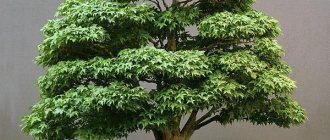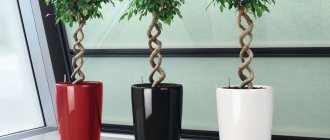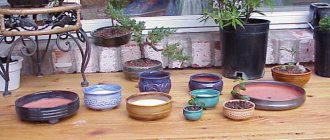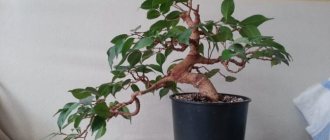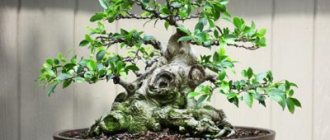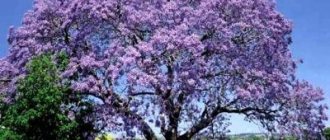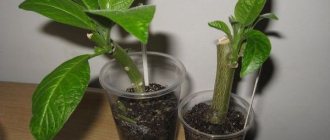Sakura bonsai can reach large sizes in natural conditions. With proper care, it will fit in a small pot, while remaining an exact copy of a Japanese cherry. Sakura is a recognized symbol of East Asia, the flowering of which is accompanied by national holidays. It is possible to grow a reduced reproduction of such a tree at home, but this process is long and painstaking.
Sakura from seeds: preparation for planting
The basis for growing any crop is high-quality seed material. Sakura seeds can be bought at specialized retail outlets. Seed germination is poor - no more than 20%. On this score, gardeners advise:
- buy more material;
- use products from different manufacturers to determine who has better quality.
Sakura seeds
The process of planting a tree requires the following actions:
- Perform stratification. For seeds, you should imitate natural winter weather. To do this, put them in a bag of wet sand and place them in the warmest compartment of the refrigerator. At a temperature of +4...+5 °C the material should be stored for at least 2-3 months.
- A couple of days before planting, soak the seeds for a day in lukewarm water.
- To help seedlings break through the seed coat, scratch or pierce the outer layer mechanically.
Sakura seeds are planted in calcined or otherwise disinfected coarse sand. This substrate is most suitable for germinating seeds and, in addition, will protect the crop from diseases. An alternative to sand is moss or vermiculite. Use a wide and shallow container as a pot. Be sure to have drainage holes.
Which container is better to choose?
To optimize cultivation, you should ensure the correct dimensions and parameters of the containers in which the seeds will grow. The container used should be wide enough for freedom of growth and development of the plant.
The depth should be approximately 5 centimeters - this way the root system at the initial stage of growth will have enough space for active growth. Be sure to make sure that the container has drainage holes, because normal water circulation allows you to saturate the plant with the elements necessary for development.
How to plant and pick sakura at home
Proper planting is half the success of future sakura growing:
- treat the seeds with a fungicide;
- moisten the substrate;
- deepen the seeds half a centimeter into the grooves made (there should be at least 3 cm between them);
- cover the planting with a thin layer of fine-grained sand;
- cover the pot with film or glass;
- leave at a temperature of +5…10 °C.
Attention! Gardeners recommend planting seeds in the spring or at the turn of August and September.
Seedlings should appear in 1.5-2 weeks. Until this point, care consists of keeping the top layer of soil moist, providing plenty of light, and gradually raising the temperature to room temperature. When shoots appear, plant them in separate pots. The distance between seeded seedlings should not be more than 10 cm if you move them to a new common container.
Sakura blossom
Picking is an important condition for the normal development of sakura. Repeated transplants help strengthen the root system. Sakura seedlings are left untouched only in the cold season. They are placed in a cool, shaded room until spring. The key point in picking grown seedlings is the selection of new pots. The gardener has two options:
- leave the crop to grow in a cramped container and form a bonsai version of the tree;
- move it to deeper and wider pots and prepare the tree for the garden.
Picking
Plant picking is extremely important for the development of a tree. The first picking should be carried out immediately after germination. Small seedlings are planted in 100 ml cups. The substrate is made up of 7 parts turf soil, 3 parts sand (disinfection and roasting in the oven are mandatory) and 1 part humus. During the first pick, the root is shortened by 1/3.
The second picking of plants is carried out after 2 months. During the period of work, the root is pinched by 2/3 and the plant is slightly buried. The soil used is of the same composition.
The third pick is carried out after the sakura grows. But not more often than 2 months after the second procedure. It is recommended to repot the plant when the plant to pot height ratio is 2:1.
Features of tree care
Sakura varieties have many differences in cultivation techniques. To grow bonsai sakura, the roots are shortened every season, and horizontal cuts are made on the bark, right on the trunk. For a garden tree, these methods are irrelevant - you form a seedling in a room, and then transplant it into open ground.
The rules for caring for a specific variety differ. A common feature is that trees are capricious and require daily attention. The tree needs soil enriched with humus, potassium, and nitrogen. During the season, sakura is watered with half a glass per day, in winter - less often. The plant needs good lighting and the absence of drafts.
Sakura bonsai
The secret of the beauty of sakura is not only in large and abundant flowers, but also in the aristocratically built crown. It can be formed starting from 2-3 years of age of the plant. In the natural and miniature versions, the branches are arranged according to the same pattern. The crown can mean a straight trunk, a bend in the spirit of centuries-old Japanese cherry blossoms, or widely spread branches.
Advice. To create a wide crown, prune the main shoot when you think it is tall enough. You can also trim the side shoots to correct their direction.
Description of the variety
Japanese sakura bonsai is an ornamental tree that easily takes root in the home. It is resistant to increased indoor air pollution, but requires good lighting and daily watering.
Sakura is valued for its unusual flowers; in bonsai they reach 1 cm in diameter. In nature they are bright pink, but you can buy artificially bred varieties with red, green, purple and other colors. Individual flowers are collected in inflorescences.
How to prune bonsai sakura correctly
To grow miniature crops, experts use various tricks and techniques. The goal is to make even a young tree look like a hundred-year-old tree. For this:
- Expose some of the roots by removing a small layer at the base of the trunk. It should be thick. To do this, regularly remove all vertically growing shoots.
- The barrel should not be too long. Cut off part of the root at its base. When replanting, deepen the cutting area into the ground. Over time, new roots will grow on it. Then the tree can be picked again, removing the old rhizome.
- The heaviest branch of the tree will be the bottom one. Which shoot to leave for its formation - decide based on the compositional idea.
- For a broom-shaped crown, prune vertically growing branches as much as possible. For a vertical one, on the contrary, protect vertical branches. In this case, only horizontal ones are cut.
The bonsai tree needs all these manipulations constantly. Otherwise it will lose its shape. The gardener's goal is to maximize the decorative effect of sakura. If you adhere to cultivation technology, provide the plant with a little care and attention every day, then the Japanese guest will delight you with lush, large and bright colors every spring.
Diseases and pests
Well-groomed plants are usually rarely attacked by pests and diseases, but you still need to keep in mind the possible dangers that await the grower when growing decorative sakura.
Most often, trees are affected by powdery mildew , which appears when the soil is waterlogged and there is insufficient lighting. The same reasons can contribute to the spread of fungal infections. Both the first and second diseases should be combated with the help of fungicides.
Insects cause considerable damage: red mites, woodlice, beetles, bark beetles and aphids. Insecticides will help to cope with pests, which need to be used not only de facto, but also preventively in the form of spraying.
Reference . Fungicides (from the Latin fung - “mushroom”, cide - “to reduce”) and insecticides (from the Latin insect - “insect”, cide - “to reduce”) - substances for combating plant diseases and their pests, having a chemical or biological origin.
The most common fungicide is “Fitosporin”; in addition, it is recommended to use “Sporobacterin” and “Insectobacterin”. To combat insects, it is recommended to use systemic insecticides , for example, Aktara.
Forming the correct shape
Constant pruning of the roots and shoots of the tree helps to restrain growth. To weaken the sakura, horizontal cuts are made on its trunk with a sharp knife. The juice of the plant is released from them. Losing moisture and nutrients, the tree weakens and slows growth. It is very important to make the cuts the right size. Excessive loss of sap can lead to the death of the plant.
Bonsai wire is used for the same purpose. It is pulled over the tree trunk, preventing it from developing. When the sakura reaches a height of 25-30 cm, the top is cut off. From this moment on, the tree will grow to the sides, releasing side shoots.
Pruning must be done before sap flow begins. If after pruning there are high-quality cut shoots left, they can be used for cuttings. Pinching shoots and branches will help increase the density of the crown. The more often pruning and pinching is done, the thicker and smaller the crown will be.
The tree is formed by fixing the shoots in the desired shape and directing their growth in the desired direction using special bonsai wire. To obtain the necessary bending of the trunk or branches using wire, the branches are wrapped with it. When using wire, you need to make sure that it does not grow into the bark of the plant. To do this, you need to periodically remove it and rewind it in a new place.
The location chosen for the bonsai will determine the shape of the crown. If the light in the room is not diffused, the plant will have a more developed crown and stronger branches on the side where more light falls. When the tree is on the windowsill, it must be constantly rotated so that the chosen style is not disturbed. Morning and evening lighting will be optimal for a bonsai plant. It is recommended to place the tree in the shade from 11 a.m. to 4 p.m.
To make a beautiful tree at home, it needs to be provided with optimal lighting. Sakura is a light-loving plant; it needs a lot of bright light. Therefore, in winter and on cloudy days it is necessary to use additional lighting. With a lack of light, the shoots become thin and the petioles of the leaves become long.
In the spring, the plant is fed with ammonium nitrate, and in the fall with superphosphate and potassium sulphide. The tree slows down in poor soil. Therefore, fertilizers for bonsai plants should contain a minimum concentration of nutrients.
Typical beginner mistakes
Sakura is considered a difficult type of bonsai to care for. To grow it, it is advisable to have basic skills in caring for such a crop, acquired by forcing simpler species - myrtle, olive tree, Benjamin or Microcarp ficus. Typical mistakes made by novice amateurs include:
- excessive watering. Knowing the danger of skipping watering, amateurs pour water into the pan, hoping that the plant will take “as much as it needs.” As a rule, the tree dies within a week;
- non-compliance with temperature and seasonal regimes - fertilizing in winter and the decision to add lighting with a regular lamp. Because of this, in the air already dried out by central heating, the plant suffers more;
- The wire is pulled too tightly on the stem. When the wire cuts into the bark, it injures it. The tree suffers such damage painfully.
It should be noted that those who begin to grow difficult-to-care bonsai cannot do without the death of seedlings. If you analyze your mistakes and learn from what happened, this can be avoided next time.
Sakura is the common name for certain types of cherry trees. Their harvest is meager, but during flowering the plants amaze with their beauty. A guest from Japan can be grown from seeds in domestic gardens. A home tree can be the size of an ordinary sakura or be a copy of it several tens of centimeters high. Gardeners share their experiences, photos and video recommendations on how to avoid mistakes and successfully go through the long journey of growing a tree.
Similar plants
When purchasing sakura seeds, you may encounter the fact that sellers unknowingly sell seeds of very similar plants that are distantly related to it.
For example, Sakhalin cherry (Cerasus sachalinensis), growing in Primorye, Sakhalin and the Kuril Islands. This is a tree with a reddish trunk and leaves like a cherry, growing up to 8 m.
Another plant belonging to the variety of finely serrated bird cherry (Padus serrulata) has a surprisingly beautiful bark color, but is not a botanical relative of sakura. In some cases, sakura is confused with the three-lobed almond (Amygdalus triloba).
Advantages and disadvantages according to reviews
As practice shows, anyone can grow sakura bonsai - if only they have the desire and patience.
Among flower growers there is a community of bonsai lovers and special fans of decorative sakura. They exchange tips and recommendations, share experiences on forums, and show photographs of their pets.
The popularity of this plant is so great that you can often find artificial sakura bonsai in stores. However, many note that the seeds almost never germinate, and recommend growing plants that are more suitable for the conditions (apricot, cherry, plum), which are similar in appearance to sakura.
Reviews and recommendations from experienced cherry bonsai growers can be read here and here.
